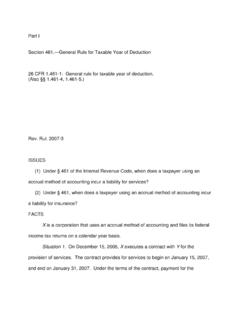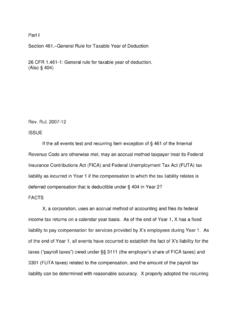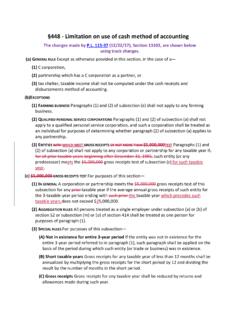Transcription of Tax Deductibility of Unpaid Employee Welfare Benefit Claims
1 June 30, 2009 2455 East Sunrise Boulevard Suite 300 Fort Lauderdale FL 33304 Tel: 954-564-4300 Tax Deductibility of Unpaid Employee Welfare Benefit Claims Page 1 When is the expense of Incurred But Not Reported (IBNR) Claims Deductible? The rules governing the Deductibility of Incurred But Not Reported Claims in an Employee Welfare Benefit program are complex. This complexity has led benefits and accounting professionals of every stripe to offer differing interpretations to clients and employers. The purpose of this Position Paper is to clarify those rules and the circumstances under which employers may claim a deduction under self-funded health and Welfare plans sponsored by single employers and not subject to collective bargaining.
2 The Paper addresses such key points as: An overview of the applicable sections of the Internal Revenue Code of 1986 (Code) A discussion of the tax issues including the applicability of cash versus accrual accounting methods Judicial interpretation of the All Events test before and after the advent of Economic Performance The inescapable grip of the General Dynamics decision Revenue Procedure 2008-52 (which appears to contradict in part the General Dynamics decision) The authors conclusions about the tax issue and the Trust or Other Fund issue Wayne W.
3 Wisong, JD, LLM Juan N. Kelly, ASA, EA, MAAA. Overview The rules governing the Deductibility of Incurred But Not Reported Claims (IBNR) in an Employee Welfare Benefit program are complex. The purpose of this Article is to clarify those rules and the circumstances under which employers may claim a deduction. 1 Sections 419 and 419A of the Code together limit deductible employer Welfare Benefit fund contributions (whether paid or accrued ) to the sum of: (1) the qualified direct cost for the taxable year , and (2) any addition to a qualified asset account.
4 Paragraph 419(a)(2) of the Code contains a clear limiting mandate that such contributions are deductible only in the taxable year in which paid , leaving the authors with no doubt that the Deductibility of contributions to a funded Welfare Benefit plan is determined only on a cash accounting basis, even in the case of a taxpayer who is otherwise on an accrual basis of tax accounting. Qualified direct cost is the amount of benefits expense (including administrative expenses) which the employer could have deducted during the taxable year if it was under the cash accounting method.
5 In other words, it is the benefits paid during the year plus related paid expenses. 1 Plans with 10 or more participating employers (whether multiemployer or multiple employer) and collectively bargained plans with 50 or more participating employees are generally not subject to the rules relating to IBNR which are discussed in this Paper. See Internal Revenue Code 419A(f)(5) and (6). 2455 East Sunrise Boulevard Suite 300 Fort Lauderdale FL 33304 Tel: 954-564-4300 Page 2 A qualified asset account is defined as any amount set aside for the payment of disability, medical, supplemental unemployment, severance or life insurance benefits.
6 However, deductible contributions to a qualified asset account may not exceed the account limit, which is defined as the sum of Claims for such benefits which are incurred but Unpaid (as of the end of the taxable year ), plus any associated administrative costs for such Claims . One component of Claims incurred but Unpaid is Claims which are incurred but not reported to the plan by the end of the year . These are known in actuarial and accounting practice as IBNR. Unlike Unpaid Claims incurred which have been reported, IBNR can only be estimated.
7 The rules also limit the deduction to actuarially necessary amounts, and further provide that unless there is an actuarial certification, the deduction for additions to the qualified asset account is limited to specified percentages of qualified direct cost. In the case of medical benefits it is up to 35% of qualified direct costs exclusive of insurance premiums, to the extent reasonably and actuarially necessary. (This so-called 35% safe harbor is more accurately characterized as an unsafe harbor as careful examination of IRS 9818001 will reveal.)
8 These Internal Revenue Service ( IRS )-enforced rules allow additional deductible contributions to a qualified asset account for pre-funding certain post-retirement benefits. This paper does not discuss that aspect of these rules , nor to any significant extent, the tax treatment of qualified direct cost. Instead, it focuses strictly on the Deductibility of IBNR under both cash and accrual accounting theories. It also does not address the accounting of IBNR for financial reporting purposes, which may or may not differ based on generally accepted accounting principles ( GAAP ) or other appropriate standards governing sound professional accounting practice.
9 The tax issue Theories on Deductibility of IBNR in an unfunded setting When the terms of a plan require all benefits to be paid from a trust or other Welfare Benefit fund, there is no question in our view that the employer can only deduct what it actually contributes to the fund by the end of the taxable year . This includes IBNR estimated and certified by the actuary. Since the mandate of 419 applies to contributions paid or accrued and since that rule clearly limits the deduction to amounts paid in that taxable year , the conclusion that it cannot be accrued merely for tax purposes seems irrefutable.
10 In other words, an employer cannot claim the deduction for one taxable year (based only on accrual accounting rules ) but actually contribute or pay it in a later year . The question remains - what if a Welfare Benefit plan is either completely self-funded (has no trust or other fund ), or if the plan gives the employer the option of paying all or some benefits directly instead of through the trust or other fund? In that situation, can an accrual basis taxpayer simply accrue the liability for the IBNR and take the deduction for it, assuming it is otherwise properly determined and fixed by year end, even though it actually pays it in the next taxable year ?




